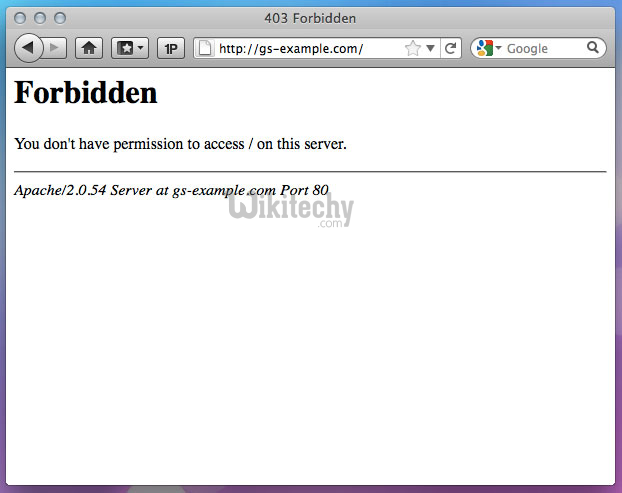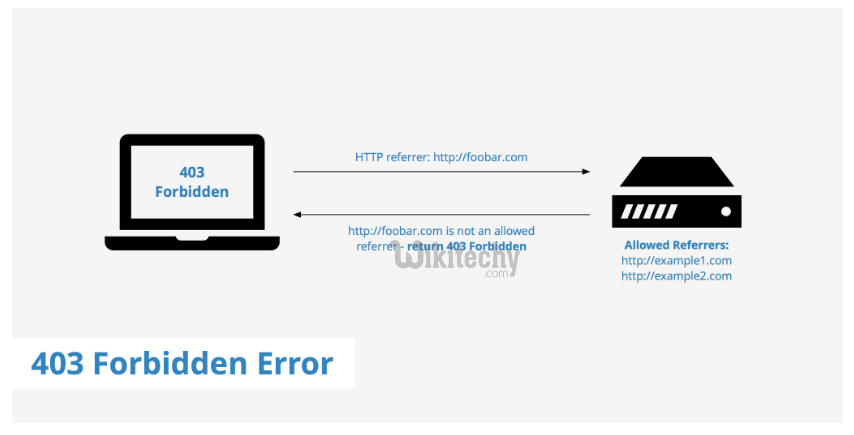apache tutorial - 403 forbidden Error - apache - apache web server - apache server - apache2
- A 403 forbidden error is an HTTP status code that can be returned from a web server to a client for a variety of reasons including
- IP blocking,
- bad file permissions, or
- if a user tries to access a hidden file.
- The web server will return a 403 forbidden error based on rules that are configured that tell the server when to deny certain requests.
- There are multiple variations of the 403 error which you might see dependent upon which server you are using. A few examples include:
- Error 403 Forbidden
- 403 Error
- Forbidden
- 403 Forbidden
- Nginx 403 Forbidden
- 403 Forbidden: Access Denied
- HTTP 403 Forbidden
- 403 Forbidden Error
- 403 Forbidden Nginx
- hostgator 403
- error code 403 22

- forbidden meaning – access denying on a file can be given with this 403 error message.
1. status code 403 - Problem:
- When we try to access our site in a web browser, we may receive a 403 forbidden error message.
- Furthermore, we may see entries in the runtime error log similar to the following line:

2. http 403 - Cause:
This problem 403 error occurs when any of the following conditions is true:
- There is no index file in the document root directory (for example, there is no index.html or index.php file in the public_html directory) which arises status 403.
- http status code 403 - Permissions are set incorrectly for either the .htaccess file or the public_html directory:
- The file permissions for the .htaccess file should be set to 644
- read and write permissions for the user, and
- read permissions for the group and world).
- The permissions for the public_html directory should be set to 755
- read, write, and execute permissions for the user, and
- read and execute permissions for the group and world.
- When the 403 area code error occurs, this often indicates that the permissions for the public_html directory are set incorrectly to 644 which may arise 403 forbidden access is denied.
- Caching -> A previously requested version of a URL returning a 403 forbidden error it may be cached in the browser. Clearing your cache may solve the problem. So that, you aren’t being served with old files.
- http forbidden - Accessing Hidden Files / Wrong URL -> If a user tries to access hidden files stored on your web server such as the .htaccess file, this will also return a 403 forbidden error.
- Hidden files are not meant to publicly accessible which is why the server restricts them and lets the user know they are forbidden to access them.
- Similarly, if a user incorrectly enters a URL, a 403 forbidden Nginx error message (or something similar) may also occur depending on what they have entered, for example, a directory instead of a file path.
- nginx 403 - Fixing an Nginx 403 Forbidden Error
- In addition to the 403 error causes mentioned above, there are also a few things you can do to troubleshoot for Nginx 403 forbidden error.
- No index file defined – When there is no index file present in the directory defined with the index directive, this can result in an nginx 403 forbidden.

For example, consider the following index directive:
index index.html index.htm index.php;click below button to copy the code. By Apache tutorial team
- Nginx will search from left to right for the defined index files. Starting with index.html and ending with index.php, if none of the defined files are found, Nginx will return a 403 error.
- IP based restrictions – Your nginx.conf file should also be verified to ensure you are not unintentionally denying a particular IP. Check the configuration file for directives similar to deny 192.x.x.x; which will block said IP from accessing a particular directory, website, or your complete server (depending on where you define it).
- Autoindex Off – With Nginx, if you don’t have an index file then a request gets passed on to the ngx_http_autoindex_module. If this module is set to off then you will likely receive a Nginx 403 forbidden error. Setting this module to on should resolve the 403 error. For example:
location /directory {
autoindex on;
}click below button to copy the code. By Apache tutorial team
3. 403 forbidden error fix or 403 forbidden access is denied how to solve :
- First, make sure there is an index page in the document root directory.
- Next, make sure the correct file permissions are set for the .htaccess file.
- Type the following command at the command prompt:

- how to fix error code 403 - To set the correct file permissions in the public_html directory. Then type the following command at the command prompt:

4. Differences Between 403 Forbidden and 401 Unauthorized Errors
- A 401 – Unauthorized error occurs when a request to a particular resource that requires authentication either does not provide authentication or the authentication provided fails.
- A 403 error on the other hand, is returned when the authentication process is passed, but the user is not allowed to perform a particular operation or the operation is forbidden to all users.
